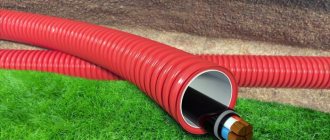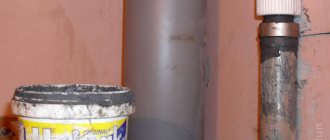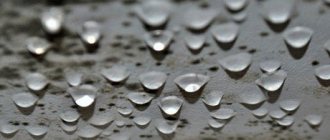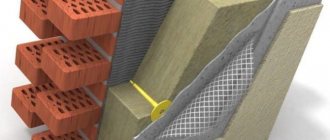How to calculate the dew point in a frame house and why the insulation gets wet
When building and designing all houses, it will be extremely important to correctly calculate the dew point in a frame house when building walls. Incorrect calculation of the dew point and/or complete disregard for this indicator can destroy the house from the inside.
Taking into account the dew point in the construction field can protect against the destructive influence of the external environment.
The nature of the appearance of dew
Water condensation on various surfaces occurs as follows.
Atmospheric air is always more or less saturated with water vapor. As the temperature drops, water changes from a gaseous state to a liquid state. This occurs when the surrounding air comes into contact with cooler surfaces and heat loss occurs. This leads to the formation of water droplets. Morning dew is easily explained by the laws of physics
The temperature at which water vapor from the air changes its state of aggregation to liquid is called the dew point.
The higher the content of water vapor in the air (or other gas mixture), the higher the condensation temperature of water, or dew point. For example, at 100% relative humidity, the dew point is exactly the same as the air temperature. Conversely, the lower the relative humidity, the lower the dew point. This means that for condensation to form, the air must be cooled more.
What is dew point
The dew point is the temperature at which condensation begins to form.
This term refers to the temperature at which air becomes saturated with water vapor to the limit. When cooled below the critical point, drops or fog form on objects.
This phenomenon is based on the fact that the maximum steam production of a cubic meter of air varies depending on its temperature.
Examples (data given in grams):
- -5°C – 3.25.
- 0°C – 4.85.
- +10°C – 9.41.
- +22°С – 19.44.
- +28°С – 27.26.
The relative humidity value shows what the current set amount of water vapor is in relation to the maximum possible amount. For example, if this parameter is 34.5% at a temperature of +28°C, then the water vapor content in the air will be 27.26*0.345=9.4047 g/m3. From the above statement it follows that when the air is cooled to +10°C, the relative humidity will reach approximately 100%, i.e. this temperature is the dew point under given conditions. If the air cools further, too much water vapor is produced, some of which condenses.
Psychrometer
A more convenient and accurate device for measuring relative humidity is a psychrometer (from the ancient Greek ψυχρός - “cold”) (Fig. 6).
Rice. 6. Psychrometer (Source)
A psychrometer consists of two thermometers, which are fixed on a common scale. One of the thermometers is called a wet thermometer because it is wrapped in cambric fabric, which is immersed in a reservoir of water located on the back of the device. Water evaporates from the wet fabric, which leads to cooling of the thermometer, the process of reducing its temperature continues until the stage is reached until the steam near the wet fabric reaches saturation and the thermometer begins to show the dew point temperature. Thus, the wet bulb thermometer shows a temperature less than or equal to the actual ambient temperature. The second thermometer is called a dry thermometer and shows the real temperature.
On the body of the device, as a rule, there is also a so-called psychrometric table (Table 2). Using this table, you can determine the relative humidity of the surrounding air from the temperature value shown by the dry bulb thermometer and from the temperature difference between the dry and wet bulb bulbs.
However, even without such a table at hand, you can approximately determine the amount of humidity using the following principle. If the readings of both thermometers are close to each other, then the evaporation of water from the humid one is almost completely compensated by condensation, i.e., the air humidity is high. If, on the contrary, the difference in thermometer readings is large, then evaporation from the wet fabric prevails over condensation and the air is dry and humidity is low.
Scope of application of the concept
The transition of moisture into a liquid state significantly changes the living and working conditions of people and affects the functioning of structures and mechanisms. Therefore, in many areas, special attention must be paid to the location of vapor deposition.
Construction
The shell of most buildings is vapor permeable. The exception is metal workshops and garages. The relative humidity indoors is higher than outdoors, and water vapor penetrates the walls under partial pressure.
Buildings have vapor permeability, which depends on the type of building material.
If there are areas in their thickness with a saturation temperature or lower, condensation occurs, causing these effects:
- Reduced thermal resistance of the structure.
- Reducing the service life of building materials. When it gets colder, the water turns to ice and expands, causing internal damage.
- Development of mold and fungal colonies (when the surface is wet).
Building materials have different vapor permeability. The lowest is in heavy reinforced concrete (buildings with floors) - 0.03 mg/m*h*Pa, the highest in aerated concrete blocks - 0.23 (at a density of 400 kg/cubic m).
Agriculture
When the air temperature drops, moisture condenses on the shoots and leaves of plants. If repeated frequently, this leads to disease. Thus, knowledge of the condensation point allows you to plan preventive and therapeutic measures.
Moisture condenses on the leaves of plants.
On the other hand, in arid regions, condensation of atmospheric moisture can partially replace the irrigation system. Breeders are working to develop varieties that can absorb water in this way. Knowing the critical point will then help determine the required irrigation capacity if the weather forecast does not predict rain in the near future.
Conservation measures for some plants, such as grapes, are also planned taking this parameter into account. If it is high, it means there is a lot of moisture in the air and frost damage, including radiation damage, will be moderate.
If the dew point is low, cover the shoots or water the area.
Where should the dew point be?
The ideal location for the dew point in a wall is the insulation on the outside of the wall. The thickness of the insulation on the wall should be such that during the coldest period of time, condensation does not flow into the wall itself, and if it does flow, it does not remain there for a long time.
Dew point isolated
The destructive effect of dew point in the body of a load-bearing wall can be seen in the following article.
Walls based on porous materials, such as foam blocks and sandwich blocks, brick and similar materials, require a higher layer of thermal insulation, since they absorb and accumulate moisture. Therefore, even a short-term (a few days) dew point in a porous wall can have a detrimental effect on the internal integrity. Thus, so-called warm masonry materials can only be effective in certain regions where winters are less frosty.
However, if it is predicted that the dew point will periodically move deeper into the wall of the house, or if this is likely, this fact should be taken into account when choosing masonry materials. In such cases, high-density masonry materials that can withstand several freeze-thaw cycles without damage are well suited. With a high frost resistance coefficient. Such frost-resistant materials include brick and foam concrete.
Frost resistance indices of the most commonly used wall materials
How to calculate the dew point in a wall with insulation
It is impossible to accurately calculate one place in the wall where condensation will form. Because the dew point depends on several parameters and is a variable value. You can only calculate a certain distance in the thickness of the wall where liquid will form under different temperature changes outside the house.
For example, if the indoor temperature is stable and the temperature outside becomes colder, the dew point will move along the thickness of the wall, closer to the room.
This formula can be used to calculate the dew point as accurately as possible for both homogeneous and multi-layer walls.
Calculating the dew point for any multi-layer wall is quite simple; the following data is required:
- Dew point at relative humidity in your area (table below)
- External temperature
- individual thickness of each wall layer
- internal temperature
- Thermal conductivity coefficient of the material from which the walls of the house are made
To determine in which part of the designed wall the dew point and condensation will be located, you need to know two values.
- The dew point temperature in our region, as well as the humidity and temperature inside the building of interest to us. We can see this in the table above. Let's call this indicator Tp (dew point).2
- The air temperature that will occur at the boundary of two layers of the wall at the values of interest to us. Let's call this number Tc (the point between the layers).
If the difference between the above values is positive, the dew point is inside the insulation, if the value is negative, the dew point will accumulate liquid inside the wall or house.
In other words, if the temperature at the interface between the insulation and the wall is higher with a positive sign than the dew point temperature from the table, condensation will form in the insulation.
Let's take the following conditions as an example:
The dew point temperature in a region with 60% humidity and a room temperature of 21ᵒC according to the table will be 12.9ᵒC. The air temperature at the interface between the thermal insulation and the wall is 15 ᵒC.
The difference between these values is 15 ᵒC – 12.9 ᵒC = +2.1
If the difference between the above values is positive, as in our case, the dew point is in the insulation, if the value is negative, the dew point will collect liquid inside the wall or house.
In our case, the temperature of liquid vapor release occurs before the saturated air reaches the main wall. And condensation will settle in the insulation, and not in the load-bearing wall of the house or inside the house.
This raises the question: if we take the dew point temperature at a given humidity level from a given table, how do we calculate the temperature between the layers of the wall?
The temperature at the boundary between two wall layers is relatively easy to calculate using the following formula:
Tc (temperature between wall layers) = (t2 – t1)x (S1x0.01/k) / (S1x0.01/k), where:
t2 – internal air temperature
t1 – external temperature
S1 – wall material thickness
k – thermal coefficient of the wall material
Simple example:
Let's take as an example a region where the dew point is 12.9 ᵒC in a region with 60% humidity, the indoor temperature is 21 ᵒC, and the outdoor temperature is 12 ᵒC below zero.
Now we need to calculate for these conditions what the temperature will be between a standard 38 cm thick one-and-a-half brick wall and a 10 cm thick external foam insulation. Subtract the dew point temperature from the table.
To do this, we will use the formula given above.
Tc (temperature between wall layers) = (t2 – t1)x (S1x0.01/k1) / (S2x0.01/k2)
According to the convention:
t2 = +21ᵒC (indoor air temperature)
t1 = -13 ᵒC (outside air temperature)
S1 = 38 cm (wall thickness)
K1 = 0.6 (thermal resistance coefficient of brick)
S2 = 10 cm (foam insulation thickness)
K2 = 0.04 (foam thermal resistance coefficient)
Calculation of the temperature between the brick wall and the foam insulation, under the climatic conditions we have chosen, will look like this:
( +21 – (-13ᵒC))x(38×0.01/0.6) / (10×0.01/0.04) = 9.52
According to our calculations, the temperature between a 10 cm thick foam core and a 38 cm thick brick wall, when the outside temperature is -13 degrees Celsius and the temperature inside the house is +21 degrees Celsius, is 9.52 degrees Celsius.
Therefore, if we subtract 12.9 degrees Celsius from the temperature between the insulation and the wall, which is 9.52 degrees Celsius, we get 9.52-12.9 = -3.38.
The calculated dew point is in the wall.
As you can see, the dew point is negative, i.e. the brick wall will reach a state of condensation and moisture will accumulate in it.
The above dew point calculation is more accurate with an error of up to 0.5 degrees Celsius, unlike some online calculators and other devices that do not take into account different material structures.
Search for a point
The exact location of the point depends on several factors:
- wall materials;
- outside temperature;
- room temperature;
- humidity - outside and inside.
The calculations are easy to do. Anyone who plans to insulate a house must first understand this issue. It is important to carry out the work according to the rules. The point is the temperature when steam turns into droplets, that is, condensation occurs.
The normal temperature in living rooms is + 22 degrees, closer to the floor it is usually a little lower, and near the ceiling it can reach + 27 degrees. In the central part of Russia, the minimum indicator for the environment is minus 15 degrees, short-term decreases to minus 20-25 are acceptable. In the southern regions, the maximum minus is 7, with a rare drop to minus 10-15 degrees.
Humidity in rooms is usually taken as an average value, but not a minimum - it is about 50%. But there is a certain reserve, because in winter the air is usually drier under the influence of active heating. This reduces humidity to 30-40%. Some owners actively resist this microclimate by purchasing devices to maintain healthy humidity and growing indoor plants.
In spring and autumn, steam flows through the insulation in the opposite direction - that is, from the street side. Because of this, humidity is taken as 90% for calculations.
Dew point calculation online calculator
There are many programs on the Internet that can be used to calculate the approximate position of the dew point on the wall. The program calculates the dew point based on a number of criteria that must be entered manually. It includes information about the material from which the wall will be built, the number and thickness of layers of the wall, air temperature inside and outside the building and humidity. The online calculator is easy to use for calculations. Along with digital calculations, you can see charts and graphs of dew point movement depending on changes in air temperature. However, the calculation results of many calculators vary, and the accuracy of the calculations is unknown.
Online dew point calculator
Thermal insulation material
It is better to use thermal insulation that is installed outside the building. Usually this is polystyrene foam, penoplex, stone wool. There are several types of mineral wool insulation; they have good vapor permeability. Some of the moisture remains in the insulation and flows down under its own weight. The material does not deteriorate in any way, because fiberglass or basalt-based fiber is not affected by moisture.
Additionally, you can install a waterproofing layer at the bottom of the building to prevent destruction of the foundation. Penoplex is vapor-permeable, therefore, during the installation process, an air pocket is maintained to remove moisture from the material. If all installation rules are followed, the walls will remain in perfect condition longer, and the effectiveness of thermal insulation will delight you for many years to come.
Material options
If you don't take into account the dew point
In the construction industry, ignoring the rules can lead to undesirable consequences. Metal, brick, concrete, wood and other materials will have a shorter lifespan. The formation of condensation in the area of polymer-density materials when installed as thermal insulation is unacceptable and leads to the following problems
- Structures fail prematurely, leading to premature failure.
- The surface of the material swells;
- Condensation is necessary on surfaces with temperatures below the dew point;
- Large areas of finishing material peel off;
- Harmful fungi and mold develop on walls, causing illness;
Regulations
The need to calculate the dew point is regulated by building codes and regulations. SP 23-101-2004 “Design of thermal protection of buildings”, as well as SNiP 23-02 “Thermal protection of buildings”. Insufficient insulation moves the dew point closer to the room.
Since the temperature in the area of window units or doors is lower than the overall calculated dew point, condensation in these segments is inevitable during the cold season. Determining the dew point is important for deciding which side to carry out insulation work on and what thickness it is more appropriate to purchase insulation.
Table . Dependence of wall material thickness on thermal conductivity
| Wall material | Coeff. heat-conducting I , W/(m* o C ) | Required thickness in meters |
| Expanded polystyrene | 0,039 | 0,12 |
| Mineral wool | 0,041 | 0,13 |
| Reinforced concrete | 1,7 | 5,33 |
| Solid silicate brick masonry | 0,76 | 2,38 |
| Perforated brickwork | 0,5 | 1,57 |
| Glued laminated timber | 0,16 | 0,5 |
| Expanded clay concrete | 0,47 | 1,48 |
| Gas silicate | 0,15 | 0,47 |
| Foam concrete | 0,3 | 0,94 |
| Cinder concrete | 0,6 | 1,88 |
Minimizing heat loss and maintaining a comfortable microclimate are the top priorities when designing and insulating buildings. Compliance with building rules and regulations, as well as sanitary and hygienic standards, will allow you to competently prepare engineering documentation and calculate the volume of required building materials.
How to move the dew point in a wall
If, after performing all the calculations, you are not satisfied with the position of the dew point, you should consider moving it. This can be done as follows:
- improve the microclimate in the room - install forced ventilation, additionally heat the air.
- increase the insulation layer on the outside;
- remove the thermal insulation layer from the inside and move it to the outside;
- Use a material with high water vapor permeability;
The appropriate option should be chosen depending on the climatic conditions of the area, the design features of the house, financial capabilities and the building materials used.
Ignoring such a phenomenon as condensation in a wall “oven” can be very expensive. The minimum is an unpleasant smell in the room and constant dampness. The maximum is large colonies of mold, damaging the interior decoration of the walls, destroying the insulation and the health of the residents. Therefore, calculating the dew point is very important if you want to build reliable and dry walls in your home.
About the dew point in plastic windows
When it comes to the dew point for plastic windows, many people imagine a certain, secret place. In reality, as we have already seen, it is impossible to see the dew point. Let's repeat: the dew point is the temperature at which water vapor in the air becomes saturated and condenses after cooling to it. There are special tables that allow you to calculate the dew point for a certain relative humidity and a certain temperature. One such table is shown below.
Dew point for relative humidity
Note. Let's assume that the air humidity is 50% and the temperature is +21 degrees. Under these conditions, the dew point is +10.2. What does it mean? If the surface temperature in the apartment drops to +10.2 degrees, condensation will form on it. As a rule, the coldest surfaces in an apartment are plastic windows, so this is where excess moisture most often gets in.
People often encounter condensation on double-glazed windows. Based on what was said above, condensation can be dealt with in two ways - increasing the temperature of the windows and reducing the humidity in the apartment. A comfortable level of humidity can be achieved by ensuring normal air exchange. Any excess moisture - from laundry, a boiling pan, etc. – Any excess moisture – from washing, pots, etc. – must go away and not accumulate in the room. First of all, the apartment should be regularly ventilated. The frequency of ventilation is determined individually, but we recommend doing this for at least 10 minutes twice a day. Also, do not forget to use special ventilation valves.
Toilet finishing options: finishing with tiles, wallpaper, panels, photos
The decoration of the toilet should not only be beautiful, but also practical. It is advisable to choose decorative coatings that do not absorb odors and are easy to clean. The most popular are wall panels, tiles and, oddly enough, wallpaper.
Plastic panels are an economical and convenient way to decorate a toilet with your own hands. The cost of one square meter does not exceed $7, and the richness of the color palette is also pleasing. The consumer today is free to choose between classic plain panels, bright samples with abstract patterns and designs, as well as sheets that imitate one or another texture (marble, wood, malachite, etc.). The length of one PVC sheet is 2.5-3 meters, this is enough to cover the entire length of the wall.
Finishing the toilet with plastic panels is possible not only on the walls, but also on the ceiling. True, unlike PVC wall sheets, the width of which is usually 30 cm, for finishing the ceiling it is better to use plastic about 20 cm wide. In this case, the decorative coating will look more harmonious and neat.
Ceramic tiles are a classic of the genre. Materials of different sizes are suitable for tiling a toilet. As a rule, rectangular elements measuring 20x30 cm are laid on the walls. In order to visually expand the interior space of the restroom, it is recommended to choose tiles coated with a glossy glaze.
The tiles on the floor also feel good. However, in this case, tiling the toilet is best done using a material with a matte surface. The rough coating will protect you from falls and injuries.
Wallpaper for the toilet is a rare but possible finishing option
When choosing wallpaper, pay attention to its properties. It is desirable that the canvas be moisture resistant and have an oilcloth surface. Vinyl wallpaper is also suitable
The latest fashion hit is the so-called liquid wallpaper in the toilet, photos of which can be viewed in our gallery
Vinyl wallpaper is also suitable. The latest fashion hit is the so-called liquid wallpaper in the toilet, photos of which can be viewed in our gallery.
Harmless dew point location
There are exceptions that, when a dew point occurs, do not harm walls, windows and other materials at all. If, for example, condensation forms on the outside of a wall on thermal insulation, this will not affect the internal structure and microclimate.
This is the most favorable position for the dew point, since in cold weather drops of moisture will not penetrate the wall. The dew point can also be located on the inside of the wall itself if it is close to the outside surface to keep the interior of the structure dry.
In all other cases, side effects may occur. To avoid such consequences, under no circumstances should you insulate walls from the inside. Such isolation will lead to the following consequences:
- Rotting walls from the inside. In very bad cases and at very high dew points, internal wall rot can occur. This leads to the destruction of the building material itself. As a result, the wall may simply collapse.
- Moisture will begin to accumulate at the boundary between the wall insulation and its covering. As a result, mold grows right inside the wall and cannot be eliminated.
- Drops of moisture will gradually move towards the thermal insulation. If condensation previously appeared only in the center, then it will gradually move towards the thermal insulation, forming fungal compounds.
To avoid this condition, you must check this value regularly. If dangerous values occur, immediate action must be taken. However, you should know from the very beginning that thermal insulation has no place on the interior walls of the house.
External insulation
The position of the dew point in the insulation from the outside can be predicted only if the thickness of the insulation corresponds to the thermal engineering calculation.
A smaller layer may cause more harm than heat. The dew point can be located in the middle of the wall and move to the inner surfaces during sudden cold snaps. The inside of the wall will get wet. But it’s worth repeating - there are no identical situations; the choice of insulation and insulation methods must be made taking into account all the features of the project, layout, structures, climate, operating conditions. There are additional construction nuances when insulating, these are ventilation gaps, additional vapor barrier, wind protection, do not forget about them when starting to insulate the house. Having opted for natural cellulose insulation Ecowool, you can get any free advice from Teploservice specialists by calling 8 (812) 9999812. We will carry out insulation of any complexity at any stage of construction, repair and operation. Heating service works with certified cellulose-based insulation .
Methods for determining dew point
You can easily measure the dew point yourself. There are several methods for calculating it. It is important to choose the one that is most convenient and practical. The main thing is to understand that after calculation you can only get an approximate value, since it is impossible to determine exact data for some indicators. Let's look at each method separately.
According to a special formula
This formula is one of the most accurate ways to determine dew point. The problem, however, is that you need to know the other values in order to use them to calculate the final value. The formula looks like this:
A, b – constants (17.27; 237.7);
T – air temperature;
Rh – relative air humidity.
The error of this calculation is one of the smallest - it is only 0.5 degrees Celsius. However, it is necessary to know the temperature and relative humidity, which is not always possible.
Using special calculators
Currently, there are various online services with which you can easily calculate the dew point. In these special mini-programs, all fixed data and approximate values are already entered, which are also necessary for more accurate calculations. All you have to do is enter the required values and see the result.
The information entered usually includes the material from which the value is calculated and its thickness. However, this information must be entered for both internal and external parties. The program will then output a table with the following data:
- Minimum or maximum dew point.
- Moisture content in kg per cubic meter;
Based on this data, it will be easy to understand what condition the walls of the room are in and what needs to be applied. However, there is no guarantee that such calculators will provide accurate results, so caution should be used.
In addition, in some cases the following data is required:
- Average air temperature. The approximate outdoor and indoor temperatures should be indicated. These indicators also affect the final result of the calculation.
- Type of number. The humidity level, for example, in the bathroom should be very high, while in the living room it should not exceed 70%.
- Geographical position. The climate in different regions of the country is very different. Based on this, we can conclude that the normal dew point for the subjects is not the same. It should be borne in mind that somewhere outside the humidity level will be even higher.
- Layers of material. This line indicates what is behind the main supporting material. This is important because if there is no other room behind the wall, the dew point values will be very different.
Advanced programs can even be downloaded onto devices. They have a much higher priority than traditional online calculators because they already use much more data to produce a result, which means the dew point will be determined more accurately. In addition, immediately after the final calculation, a special graph will appear on the screen, which is a schematic representation of the dew point in the wall.
How to use the obtained result?
As you already understand, good thermal insulation is such thermal insulation (now we are talking about external thermal insulation of the facade) in which the dew point is in the middle of the thermal insulation. This parameter depends on many factors, for example, the thermal insulation properties of the insulating material decrease with increasing water content, i.e. A material with low water absorption should be used as an insulator.
How to calculate the required insulation thickness so that the dew point is inside the insulation? The properties of the insulation and walls are important here: the thicker the insulation, the faster the cold passes. From this we can conclude that a porous material will have better thermal insulation properties, and a wall made of dense concrete will require more insulation than a wall made of cinder blocks.
Relationship between dew point and construction
The dew point value directly depends on the relative humidity and temperature outside and inside the building. For example, if the temperature outside is 8˚C, the temperature inside the house is 22˚C, and the relative humidity is 45%, condensation will form on the outside wall.
There are other factors that influence dew point, such as regional climate conditions, insulation of the entire building envelope, quality and type of heating system, length of occupancy (permanent or temporary, as in a house or garage), and ventilation.
It is very important for builders to know the dew point in order to accurately calculate the location of condensation on the walls and determine the required insulation thickness. Knowing this, you can minimize heat loss during the cold season.
The location of the dew point may vary depending on the thickness of the wall. It depends on the thickness and type of materials of the wall itself and insulation, the temperature and humidity of the air inside and outside the building.
Each material used for the construction and decoration of walls, with the exception of metal, has its own degree of water vapor permeability. From a physical point of view, this is an indicator of the amount of water vapor that a material can pass through itself in a certain time.
Vapor permeability is one of the decisive factors when choosing thermal insulation materials, and is also important when analyzing the condition of external walls.
During periods of low temperatures, water vapor under pressure in the room will tend to escape through all layers of the outer walls. The lower the vapor permeability coefficient of the insulation, the smaller the layer that needs to be laid. Its coefficient should increase from the inside to the outside, as does thermal conductivity.
If all calculations are performed correctly, the dew point will be in the thermal insulation layer of the wall, closer to the outer surface. In this case, the water vapor will turn into condensation and will only dampen the wall. This is how water vapor accumulates in winter, and in summer it is necessary to create conditions for the evaporation of accumulated moisture.
The main condition for good insulation is the creation of conditions for the evaporation of accumulated moisture. To do this, it is necessary to make special calculations and select finishing materials.
Less suitable is the location of the dew point in the load-bearing wall of the house. This occurs if the wrong type and thickness of insulation is selected.
In the worst case, condensation is on the inside of the wall. This situation is possible if the wall is not insulated at all or if the insulation is located indoors. In the latter case, mold may form under the insulation, and the wet insulation will not retain heat at all.
Saturated steam, air humidity
We will devote today's lesson to discussing the concept of air humidity and methods for measuring it. The main phenomenon affecting air humidity will be the process of water evaporation, which we already talked about earlier, and the most important concept that we will use will be saturated and unsaturated steam.
If we distinguish different states of steam, they will be determined by the interaction in which the steam is with its liquid. If we imagine that some liquid is in a closed vessel and the process of evaporation occurs, then sooner or later this process will come to a state where evaporation at equal intervals of time will be compensated by condensation and the so-called dynamic equilibrium of the liquid with its vapor will occur (Fig. 1) .
Rice. 1. Saturated steam
Definition. Saturated steam
is steam that is in thermodynamic equilibrium with its liquid.
If the steam is not saturated, then there is no such thermodynamic equilibrium (Fig. 2). Rice.
2. Unsaturated steam Using these two concepts, we will describe such an important characteristic of air as humidity.
Definition. Air humidity
– a value indicating the content of water vapor in the air.
The question arises: why is the concept of humidity important to consider and how does water vapor get into the air? It is known that most of the Earth’s surface is occupied by water (the World Ocean), from the surface of which evaporation continuously occurs (Fig. 3). Of course, in different climatic zones the intensity of this process is different, which depends on the average daily temperature, the presence of winds, etc. These factors determine the fact that in certain places the process of water vaporization is more intense than its condensation, and in some places it is the other way around. On average, it can be argued that the vapor that forms in the air is not saturated, and its properties must be described.
Rice. 3. Evaporation of liquid (Source)
For humans, the humidity level is a very important environmental parameter, since our body reacts very actively to its changes. For example, a mechanism for regulating the functioning of the body, such as sweating, is directly related to the temperature and humidity of the environment. At high humidity, the processes of evaporation of moisture from the surface of the skin are practically compensated by the processes of its condensation and the removal of heat from the body is disrupted, which leads to disturbances in thermoregulation. At low humidity, moisture evaporation processes prevail over condensation processes and the body loses too much fluid, which can lead to dehydration.
The amount of humidity is important not only for humans and other living organisms, but also for the flow of technological processes. For example, due to the known property of water to conduct electric current, its content in the air can seriously affect the correct operation of most electrical appliances.
In addition, the concept of humidity is the most important criterion for assessing weather conditions, which everyone knows from weather forecasts. It is worth noting that if we compare humidity at different times of the year in our usual climatic conditions, it is higher in summer and lower in winter, which is associated, in particular, with the intensity of evaporation processes at different temperatures.
Consequences of incorrect calculations
When choosing insulation materials, it is important to remember that one of the most effective ways to protect external walls from dampness is to properly install layers of insulation.
High-quality thermal insulation will help significantly reduce heat loss and make your home more comfortable, as well as extend the life of your walls.
A thick layer that does not allow water vapor to pass through and a porous layer that allows moisture to pass out should be located on the inside of the load-bearing wall.
It is also necessary to create conditions for ventilation in the condensation zone. This way, the condensate will evaporate freely.
A properly insulated exterior wall will help reduce heat loss during the heating season from 45 to 95% and create comfort in the house.
If the thermal insulation is chosen incorrectly, moisture will gradually accumulate in it, reducing the thermal resistance of the wall. Therefore, in the second or maximum in the fifth heating season, heating costs will increase, if we are talking about a private house, the apartment will simply be much colder in winter.
Professional insulation is a long and expensive process. Today there are many insulating materials. Do not try to save on them, as cheap materials will become unusable after just a few heating seasons.
There are several consequences of incorrect calculations, but some of them can have a negative impact on your quality of life. The main consequences are constantly damp walls, mildew, mold, mildew and germs on the walls, which lead to many chronic diseases.
Constantly damp walls become a breeding ground for fungi and mold, and their spores are transmitted by airborne droplets and cause diseases.
Because wet rooms are difficult to heat, their comfort levels are reduced. High humidity in such walls can cause respiratory diseases.
Another unpleasant consequence of a miscalculation is the destruction of finishing materials - tiles crumble, bricks on the outer wall crumble, and the surface of the inner wall begins to swell.
Undried condensation is the main reason that the outer wall is susceptible to weathering and peeling of finishing materials.
To remedy this situation, the condition of the walls and insulation must be analyzed by a professional. With the correct calculations, you can correct all mistakes and create a comfortable and warm environment in your home.
The principles and formulas of thermal engineering calculations for the correct design of a house will be discussed in the next article, which we strongly recommend that you read.
Some facts
The issue of the position of the critical point in the wall is removed if you cover it from the inside with a vapor barrier material. Some types of finishes, such as vinyl wallpaper, have these properties. No steam enters the structure, and it will be dry regardless of the temperature distribution. The exception is the case when the wall freezes through and the critical point is on the inner surface.
Covering enclosing elements with vapor barriers is practiced in Western European countries. But this solution has a drawback: to remove excess moisture, you have to increase the air exchange rate, i.e. ventilation performance. This entails an increase in heat loss and, as a consequence, heating costs. A house with “breathing”, i.e. vapor-permeable walls are cheaper.
How to change the location of a point
If errors in calculations are made during the construction of a new house, this can lead to the permanent formation of mold on cold surfaces and further damage to the entire structure.
A problem in a house that has been in use for a long time can be solved by changing the main influencing factors. The following measures are provided for this:
- Organize a reliable ventilation system. If a finished building (guest house, bathhouse or cottage) is used temporarily, for example in the summer, you may notice an increase in humidity levels in all rooms. The best solution is to organize a ventilation system that provides good air exchange at any time of the year.
- Additional heating. If condensation persists on the ceiling, it means that the heating of the room is not sufficient to reduce the humidity level. The best solution is to additionally use portable heaters or household dehumidifiers.
- Make the building thermally insulated. You can move the point towards the street using façade insulation. Why is it useful to insulate walls outside? In this case, the condensation point will be between the insulator and the wall, so that even in the event of significant changes in climatic conditions, surface moisture can be prevented.
When determining the location of a point in the wall, many factors must be taken into account: climatic conditions, wind strength, sun angle, temperature, humidity conditions inside the building, floor thickness and materials.
The minimum level of humidity is specific to each type of material; the main thing is not to allow it to increase significantly. In addition, each homeowner can determine the temperature of the condensation on the surface. If thermal insulation technology is used, you can be sure of reliable protection and durability of the walls.
Factors influencing heat loss
Thermal processes correlate well with electrical processes: temperature difference acts as voltage, heat flow can be thought of as current - there is no need to create a special term for resistance. The concept of least resistance, called thermal bridges in heating engineering, is also completely correct.
If you consider any material in cross section, it is quite easy to determine the path of heat flow at both the micro and macro levels. As the first model, we will take a concrete wall in which, due to technological necessity, the through fastenings are made with steel rods of arbitrary cross-section. Steel conducts heat slightly better than concrete, so three main heat flows can be distinguished
- From steel bars to concrete
- Through the thickness of concrete
- Through the steel bars
Heat loss through thermal bridges in concrete
The most interesting model is the final heat flow. Because the steel core heats up faster, the temperature difference between the two materials will occur closer to the outside of the wall. Thus, the steel not only “pumps” heat out itself, but also increases the thermal conductivity of the adjacent concrete masses.
Thermal processes in porous media proceed according to a similar pattern. Almost all building materials consist of an extensive network of solid materials, between which there is a space filled with air. Therefore, a solid, dense material is the main conductor of heat, but due to its complex structure, the path along which heat moves is larger than its cross-sectional area. Therefore, the second factor determining thermal resistance is the heterogeneity of each layer and the entire building envelope.
Reducing heat loss and shifting the dew point in the thermal insulation of external walls
Useful tips
Ventilation must be ensured in such a way that the relative humidity in the home does not exceed normal values (40%-60%). This requires an air flow from outside. In houses and apartments with natural ventilation, it should enter through the cracks in the windows.
But when you replace windows with sealed vinyl windows, there is no air flow. Ventilation does not work, even if the exhaust ducts are equipped with fans. This problem can be solved by installing window or wall valves.
Also make sure there is a gap under the inner door.
Hair hygrometer
Let us now consider the principle of operation of other types of hygrometers, instruments for measuring humidity characteristics (from the Greek hygros - “wet” and metreo - “I measure”).
Hair hygrometer
(Fig. 5) is a device for measuring relative humidity, in which hair, for example human hair, acts as an active element.
Rice. 5. Hair hygrometer (Source)
The action of a hair hygrometer is based on the property of defatted hair to change its length when air humidity changes (with increasing humidity, the length of the hair increases, with decreasing it decreases), which makes it possible to measure relative humidity. The hair is stretched over a metal frame. The change in hair length is transmitted to the arrow moving along the scale. It should be remembered that a hair hygrometer does not give accurate relative humidity values, and is used primarily for domestic purposes.











